Bhitarkanika National Park: Mangroves and Crocs
Bhitarkanika National park is a huge expanse of muddy water
crisscrossed by rivers and creeks, fringed by a green corridor of Mangrove
forests.
I have been exploring Bhitarkanika for the last 15 years and visited
this entrancing forest many times. Through the years I have seen many changes
& developments in the sanctuary, but that doesn't pull me back in visiting
this area year after year. My craving for adventure and exploration compels me to come back
again. Every time I visit, it feels as if it's my first time and
that's what the addiction of travel is.
This travel blog is divided into two parts:
This write-up as Part 1 describes areas and sights around Chandbali town & Bhitarkanika National Park covering Bagagahana island, Forest Block island & Dangmal.
Part 2 describes only Habalikhati Island located at Gahirmatha Marine Wildlife Sanctuary. You can read from this link Habalikhati Island
LOCATION:
Bhitarkanika National Park is located in the Eastern coast of the Indian
state of Odisha, in Kendrapara district, in the estuary of the Baitarani and
Brahmani rivers.
 |
| Bhitarkanika Tourist Map. Source: Outlook Magazine |
OVERVIEW & IMPORTANCE:
The 672 sq km area of Bhitarkanika National Park is in deltas of
Baitarani and Brahmani rivers. The core area of 145 sq km was declared the
Bhitarkanika Sanctuary in 1998 and the coastal part was designated as
Gahirmatha Marine Wildlife Sanctuary in 1997. Bhitarkanika was declared a
Ramsar Site (Wetland of international importance) in 2002.
 |
| Guide Map at Khola Checkpost |
The river systems of the sanctuary are the habitats of saltwater crocodiles, the largest among all the species of crocodiles. As many as 63 species of mangroves are found here, and it is for their presence they act as a strong shield that spares the villages around Bhitarkanika from the fury of many cyclones. Many rare and medicinal plants are also found here. The mangrove wetlands are home to as many as 195 species of birds, and the heronry here is said to be one of the largest in the country.
Two species of dolphins, Irrawaddy and Bottlenose dolphins are seen here. The Gahirmatha coast has the distinction of being one of the world's largest rookeries for the endangered Olive Ridley sea turtles.
HISTORY:
The forest resources of Odisha were so vast that it was an arduous
challenge for the rulers to manage and govern them: large numbers of wild
beasts along with high density, thus making many regions virtually inaccessible.
Nevertheless, these forests were a source of revenue to many of the rulers/administrators.
Historically Bhitarkanika belongs to the Kanika Raja. A brochure issued by the Kanika family, indicates that around 1280 AD a brother of the ruling chief of Mayurbhanj, named Bhujabal Bhanj, came over to this region and gradually established himself and extended his domain from Chhamuka area to Kaldwip (presently in Rajnagar) through his political acumen and matrimonial alliance. Righagarh was then the headquarters of Kanika Raj for about five to six hundred years.
In 1576 AD, Odisha was annexed to the Mughal Empire by Akbar. The Mughals divided Odisha into two parts: the Garjhats & Killajats. The Kanika Raja falls under the Garjhats category. As the Mughals remained busy in war, they created a class of intermediaries or Zamindars who used to act on their behalf and the jungle of Bhitarkanika was ruled by them.
During the British regime, Bhitarkanika was known for its very dense forest and was believed to be very rich in both flora and fauna. This forest was named Bhitarkanika (meaning interior Kanika) due to its inaccessibility. It had a wide range of the mangroves and was home to many wild animals like leopards, porcupines, deer, crocodile, boar etc. Unfortunately, now there are no more leopards found in this region as most of the leopards became victims of the hunting practises by the then Rajas. The people residing in the region mostly depended on agriculture, hunting and fishing for their livelihood. The Adivasis of the region were also involved in activities like honey and wax collecting, basket weaving.
After independence, Bhitarkanika was under the control of the Zamindari forests of Kanika Raj till November 26, 1951. With the abolition of the Zamindari system in 1951, the jurisdiction of these forests passed on to the Revenue Department of the government of Odisha from 1952 to 1957. The mangrove forests that abound this region were the habitat of saltwater crocodiles and in 1975, a crocodile farm was established on the advice of Dr Bustard and with the help of the United Nations. The entire forest area including the rivers and creeks (total of 672 sq km) was declared as the “Bhitarkanika Wild Life Sanctuary”.
Reminiscences of the Kanika kingdom can still be found around Bhitarkanika today.
Places to stay around Bhitarkanika:
There are notably 3 places where the Orissa Forest Development
Corporation (OFDC) has permanent lodging options.
(In-depth details in 'Where to stay' section)
➖ Gupti
➖ Dangmal Island
➖ Habalikhati Island under Gahirmatha Marine Sanctuary (see Part 2)
A rough itinerary if you are eyeing for a visit here:
To properly visit Bhitarkanika you can set your itinerary like this from Kolkata city. (You can add or subtract days too according to your choice)👇
DAY 1: Board train from Howrah station at night which arrives early morning at Bhadrak.
DAY 2: Stay in Chandbali/Jayanagar/Khola and explore Rajkanika palace, Rigagarh temple. (requires hiring a car)
Dhamara port and Kalibhanjdhia island. (requires hiring a boat)
DAY 3: Set off for Habalikhati island. You will reach sometime between 1pm - 2pm.
DAY 4: Explore Habalikhati.
DAY 5: Habalikhati to Dangmal island. On the way visit Bagagahana island (visit this island if you are going between Nov - Feb) and Forest Block island. Overnight in Dangmal island.
DAY 6: Dangmal to Chandbali town and then set off for Bhadrak station. The recommended train for Howrah station is Dhauli express which arrives at 3:30pm in Bhadrak station.
THE JOURNEY:
(A summary from all my trips made into a story)
A 5night 6day trip is perfect if you are eyeing to tour
Bhitarkanika.
I started my trip from Kolkata and boarded 12839
Howrah Madras Mail train from Howrah station which departs at 23:45 and arrives
Bhadrak early morning at around 4am. This train is perfect if you want to fix a
tour of Bhitarkanika.
(There are many other trains all through the day that connects Bhadrak from Howrah station. Details are given in 'How to reach' section).
My next stop was Rajkanika palace which was located on the way to Chandbali from the temple 16km (45min). The roads are in very bad shape and take a long time to cover short distances. The 105-year-old expansive palace looks very beautiful from the gates which cover an area of 300 acres. I visited the museum inside the palace which exhibits rare photographs, antiques, hunting trophies, paintings, weapons, an old billiard table etc. It also houses the world’s largest crocodile skull (99 cm), stuffed animals like leopards, an elephant foot etc. If you are a lover of history and art, you will love this place.
In the late afternoon, I took a boat ride down the
river towards Damara port area to soak into the atmosphere of my trip. After
witnessing a cloudy sunset on Baitarani river I returned back to my hotel. A
day full of travel and I was very tired, so hit the bed a bit early as tomorrow
my Bhitarkanika adventure will begin.
After completing all the mandatory official requirements, I was now on the way towards the sanctuary. Soon I was sailing through deep mangrove wetlands and my boatman told me to keep my eyes peeled for crocodile sightings. Suddenly, the boat slowed down a bit and I can see my guide pointing at a place by the river bank. I chanced to sight a giant saltwater crocodile basking in the sun and at a distance, it looked as if like a fallen tree trunk camouflaged by the surrounding environment. The boatman said this crocodile was the biggest one in Bhitarkanika and locally known as 'Kalia' and is often found in the area between Khola and Jayanagar. The sighting of 'Kalia' the giant croc made my day.
 |
| Khola |
 |
| Kalia the giant croc as they say |
It was mid of February and the morning was a bit cold and pleasant and the sun rays gave a soothing effect. During the winter season, a lot of crocodiles can be seen on the banks of the river because very little sunlight penetrates the interior of the forest and thus becomes cold. They come out in the open to bask in the sun rays. So, if you are planning to visit Bhitarkanika during the winter season, always start your journey early in the morning just after sunrise. A lot of birds can be spotted here at this time; these colourful migrants come as far from Central Asia and Europe, 6 species of Kingfishers and many other birds are seen in large flocks. But unfortunately, am not an avid birder and maybe I need someone to fuel me the passion for birding.
There are many narrow creeks to explore around the sanctuary and
they are best done without an engine buzzing motorboat. The sound of the boat
engines scares off the birds as well as the crocodiles. Spotted many deer
grazing near the banks and occasionally some wild boars. When the tide enters,
the forest floats and the water touches the foliage. As it recedes, the
multi-layer mudflats on the banks of the creeks get exposed to different
variety of wildlife. Soft-shelled turtles, crocodiles, King cobra, Sambhar,
Chital, Fishing cats, Leopard cats, Mudskippers, Limulus crab etc. are common
to the landscape. Bhitarkanika is the biggest mangroves in India just after the
Sunderbans in Bengal. Crocodiles are also found in the Sunderbans but compared
to Bhitarkanika they are smaller in length. The beauty lies in its unique
natural surroundings. Tide marks on the soil, footprints of wildlife under the
unbroken canopy offers a splendid view of nature.
After about 1.5 hrs the boat arrived at Gupti village. Gupti was another checkpoint and also has accommodation facilities for tourists provided by OFDC. You can also start your trip from here, hire boats, and this village has road connectivity from Chandbali and Rajnagar.
 |
| Forest Dept boats in Gupti |
As I moved on from Gupti the river now widens up and meets Brahmani River. On the way, I saw many small villages, fishermen on small boats, children playing near the banks of the river and a crocodile sitting just near to them. It’s a way of life they got accustomed with. On my way, I spotted so many crocodiles and after a time, I got bored watching them but I was enjoying the journey tenfold. I wonder how the forest officials take the census of crocodiles every year in Bhitarkanika, there might be thousands of them.
BAGAGAHANA ISLAND:
Meandering through the creeks I reached Bagagahana island or formerly known as Bird Island. A large number of heronry nest on this island which is spread over 22 acres during the breeding season and a high watchtower provides a good view of the birds from above.
 |
| Bagagahana jetty |
Back in 2005, there was no jetty for boat docking, and I had to remove my shoes and get off from the boat which was a very risky affair, as crocodiles lurk in the river and also remains camouflaged in the muddy banks. I had to walk the whole muddy trail barefoot towards the bird sighting watchtower. The moment I got down from the boat, I could hear loud piercing sounds and I yelled out to my guide “is there a waterfall nearby?” and as I approached the tower and climbed up; to my amazement I witnessed thousands of birds nesting on the treetops. Their sounds can be heard from a great distance. It was truly a sight to behold. Unluckily, I didn’t witness this mass gathering of so many birds in the following years (except in Feb 2015).
 |
| The watchtower |
 |
| Painted Stork |
Now as years passed, the island has a docking point and the trail to the watchtower is paved up. You will find a large number of 'Pneumetaphores' or breathing roots of the mangroves sticking out from the ground by the sides of the trail. After spending 30 minutes on the island it was time to visit Forest Block Island.
The video below shows hundreds of birds flocking at Bagagahana for nesting. Though a bit grainy video, I shot it in 2015.
 |
| Mangrove swamps of Bagagahana |
 |
| Pneumetaphores |
FOREST BLOCK ISLAND:
Forest Block was 20 min upstream from Bird Island. The boat reached the
southern jetty of the island from where I will be taking the forest trail of
4.5km to the northern jetty. There is a dedicated trail for the tourists to
follow and they should always keep to this path. The good thing is that particularly nothing has changed since I first visited this island some years back.
It still has the natural environment.
 |
| A baby croc |
 |
| A croc near south jetty |
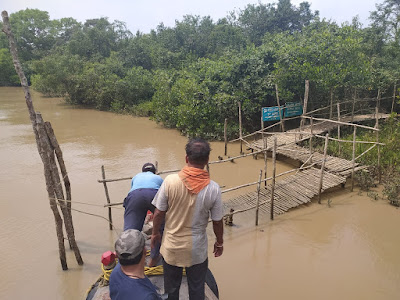 |
| The submerged south jetty of Forest Block |
Inside Forest Block Island you can spot different species of birds, wild boars, deer, butterflies, monitor lizards and the saltwater crocodiles can also, be found in the various swamps and ponds inside the forest. It is always advisable to walk the trail in groups and remaining silent to enjoy the pace of nature.
 |
| Pied Kingfisher's |
As I kept walking I came across an old hunting tower which belonged to the erstwhile King of Kanika. This island was an important game hunting zone for the kings who once ruled the region. Sadly, the hunting tower is in a very sorry state and needs restoration. There was a pond just beside the tower and as my shoes were covered in mud, I went towards the bank to wipe them off. Hurriedly my guide came up and pulled me up by my collars. As he pulled me up, a crocodile splashed into the waters. That was a close shave indeed as I couldn’t see the crocodile was silently sitting beside me just two feet away, totally camouflaged by the water hyacinth leaves.
 |
| Hunting tower |
 |
| Forest Block trail |
After getting scolded for my silliness, I continued the trail and came across two very old temples. The larger one was from the 9th century and the smaller one made completely with stone from the 5th century AD. Every destination has a history and I have a fascination for this subject and love to know more about the past as it teaches you a lot about that place. Just wonder, how the people built such beautiful temples deep in the forest during those times. I am still searching for more information regarding these temples. (If you know anything, do write in the comments section).
 |
| 9th-century temple |
On the way, I spotted a giant monitor lizard and some deer. There’s also
a big lake inside the forest which was teeming with many birds. At one point in
the trail, you will find the canopy of trees shaped like a cave or a gateway and
sunlight hardly penetrates the forest floor in this section. After a tiring
walk, I finally reached the northern jetty. My boat was waiting here to take me
to the other side of the river. Dangmal island is located just opposite of
Forest Block island.
 |
| Monitor Lizard |
 |
| A deer |
DANGMAL ISLAND:
The island of Dangmal is the most visited place in Bhitarkanika. It
houses the crocodile breeding and research interpretation centre, a museum
exhibiting the rich biodiversity of the sanctuary and many cottages for
tourist accommodation.
(Details regarding accommodation given at the end of the blog).
The island now has a jetty which moves up and down with the tides which makes it easier to get down from the boat. Back in 2005, there was no jetty and I can recollect that it was near dark and my boatman was searching with a torchlight as where he will be docking up. It was really a frightening experience, albeit a memorable one.
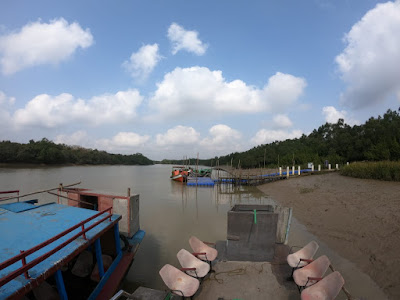 |
| Dangmal jetty |
 |
| National Park gate |
Upon setting foot on Dangmal, you need to walk towards your cottage (1.5km) or hire a Toto (a small electric powered vehicle) which charges Rs.20 per head. The causeway towards the cottages are lined with coconut trees and you can also spot herds of deer out in the open grazing on the grounds. By the sides, there are fenced small ponds where crocodiles are kept. In one such pond, you will find the White Albino crocodile. After my booking documents were checked and verified, I was directed to my cottage where I refreshed myself a bit. Now, most of the cottages in Dangmal are air-conditioned and have uninterrupted electricity.
 |
| A cottage in Dangmal |
 |
| The causeway in Dangmal |
The museum was just beside my room and as it was nearing sunset, I quickly went for a visit (museum closure time 5 pm). Inside the museum, you will find much information about the species found in the sanctuary, skulls of animals, preserved reptiles and turtles and skeleton of the biggest crocodile ever to live in Bhitarkanika.
 |
| The museum |
Gaining some knowledge, made a visit to the Crocodile
Breeding and Interpretation centre. Here you will get to see crocodile
hatchlings and how eggs are breed. Years back, the officials used to let you
handle a small crocodile hatchling in your hands, it was a wonderful feeling
back then. Now, they have stopped the practice.
As night fell the area became silent and now you will feel that you are inside a forest. There’s not much lighting around the camp and most of the areas are pitch dark. It is always advised to carry a powerful light source with you, if you want to venture outside your cottage, and never set off alone. Many wild animals roam around the cottages at night, so you should be very careful and cautious when stepping out. The wild boars are aggressive and may charge you, many kinds of venomous snakes including the king cobra, python and common krait are residents of Dangmal. I spotted a big saltwater crocodile just beside my cottage and also a common krait slithering by the road.
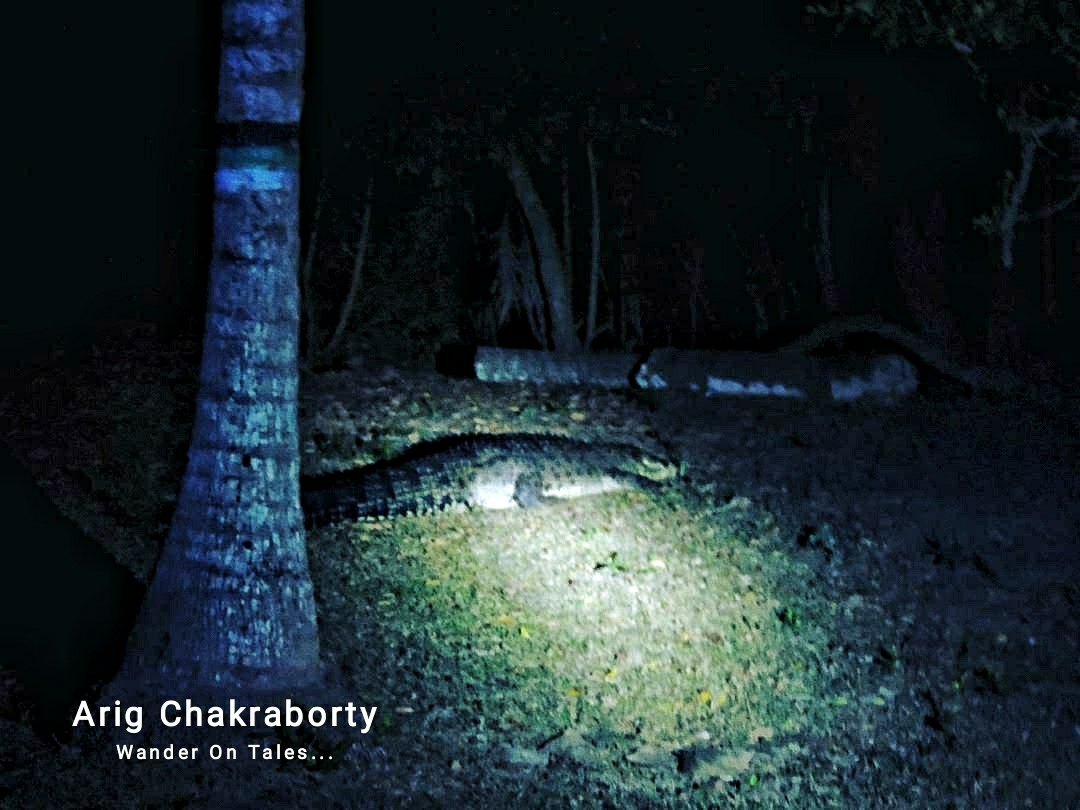 |
| the croc beside our cottage |
The dining hall of Dangmal Nature camp is a 6 min walk from the cottage and all the meals are served in there. 2 years back they used to serve the evening snacks and tea in the cottages but now they serve only in the hall. There is also a souvenir shop near the dining hall. Food in the nature camps is a mix of veg and non-veg (fish, egg or crab). Chicken or any kind of meat are strictly prohibited in the camps.
 |
| Dining hall Dangmal |
 |
| Menu chart Dangmal (Note: crab curry is rarely served) |
I along with some of my team members went out with a forest ranger to spot animals and owls after dinner. Many deer roam around the area freely. Though shy in nature, I think they got accustomed to seeing people around the camp and they do not run away easily even if someone gets a bit closer to them. The ranger said that the wild boars are the most aggressive and I shouldn’t point my light on them. We should not walk under the coconut trees as coconut may fall on our head as rats bite them off from the trees. It was so dark that we saw scores of eyes glowing inside the boundary of the forest. After a thrilling night excursion, I retired to my room for good night sleep.
Woke up in the wee hours of the morning and it was a bit foggy outside. Had a relaxing walk around the camp, had my breakfast after some time and packed up to leave Dangmal. I will be visiting Gahirmatha Marine Sanctuary today and booked two thrilling nights in Habalikhati Nature Camp. A new adventure awaits.
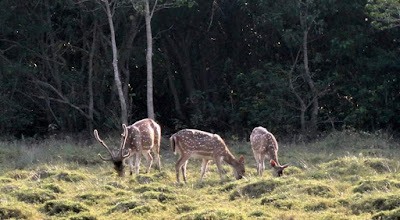 |
| Deer roaming around Dangmal |
(Read about Habalikhati
Island here PART 2).
 |
| A creaky bamboo jetty in Dangmal |
 |
| Spotted Owl's |
 |
| The journey continues towards Habalikhati |
WHERE TO STAY: 🏨
(details of Habalikhati Island in PART 2)
Dangmal
Nature Camp
13 AC
Double bedrooms, 1 Non AC Triple bedroom and 2 Non Ac Four bedroom. Room
tariffs vary between Rs.4500 – 5500 (the tariff is inclusive of all three meals
and evening snacks). You can book online from this link OFDC Eco-Tourism Booking
Gupti
Researchers Hostel
There
are 6 AC Double bedrooms. The room tariff is Rs.3800 per room (the tariff is
inclusive of all three meals and evening snacks). You can book online from this
link OFDC Eco-Tourism Booking
➖ Bhubaneswar office
- OTDC Head Office, Panthanivas (Old Block), Lewis Road, Bhubaneswar -
751014.
Khola
Sand Pebbles Resort near Khola checkpost offers 14 Non AC swiss tents with attached washrooms (double bed between Rs.4500 to Rs.7200, Triple bed between Rs.6500 - Rs.10500 and Fourbed between Rs.8500 to Rs.13600).
Sand Pebbles Resort Khola (link opens in a new window)
HOW
TO REACH:
Train
– 🚂
It’s
best to arrive Bhadrak early morning from your source station if you want to
travel to Dangmal or Gupti. Bhadrak has good rail connectivity.
➖ Howrah
station (HWH) to Bhadrak station (BHC).
➖ Bhubaneswar
station (BBS) to Bhadrak station (BHC).
Road
– 🚙
➖ Kolkata
to Gupti 410 km.
➖ Bhubaneswar
to Gupti 145 km.
➖ Those
arriving via train in Bhadrak they can either travel to Chandbali (52 km) in a
bus or shared vehicle from the station or directly to Gupti (83 km) in a fully
booked car (Rs.3000).
Air - ✈️
The
city of Bhubaneswar has the nearest airport.
Boat
Hire – 🚤
➖ Bhitarkanika is explored by motorboat and can be
approached from two entry points –Gupti and Khola. You need to contact
the DFO of Wildlife Division either in Gupti or Bhubaneswar. Rate of boat greatly
varies on the type you choose and duration.
Phone: 9437285104
Email: dforajnagartourism@gmail.com
➖ There are private boat owners too which are recognised by the forest dept. They can be booked from Chandbali & Khola.













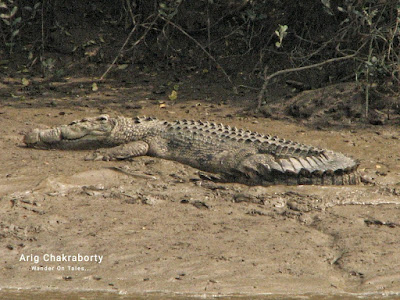
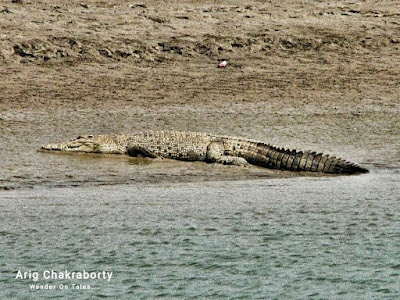











অসাধারণ পোস্ট। ঋদ্ধ হলাম।
ReplyDelete